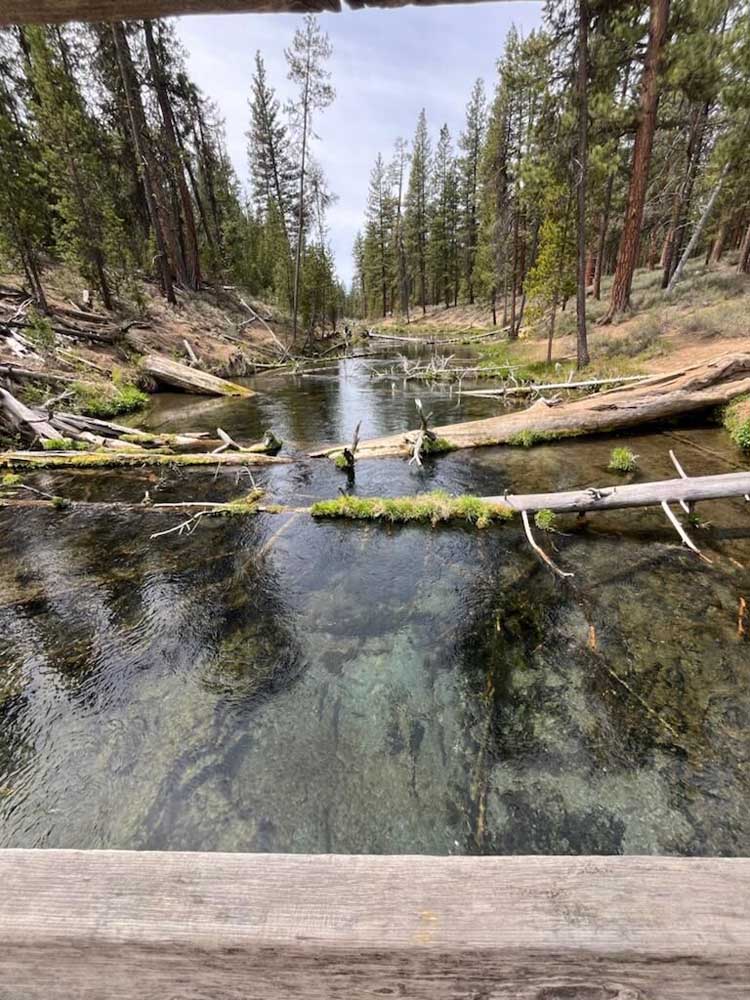Fall River in spring is a beautiful thing
Published 5:15 am Friday, May 24, 2024

- Blowdown on the banks of the Fall River offer fish plenty of places to hide. The river is stocked with legal-size brook and rainbow trout, and it's also home to naturally occurring brook, brown and rainbow trout, according to the U.S. Forest Service.
At least once a year when my wife and I are trying to figure out where we want to hike, I’ll toss out the idea of Fall River Trail, which runs through a stretch of lodgepole and ponderosa forest identical to much of the forest east of the Cascades in Central Oregon.
The comparisons can stop there, because while there’s forest for miles on one side of this fairly level and well-maintained trail, on the other is a slice of heaven on earth.
We’ve been coming to this short, concentrated gem of a river, which comes burbling out of the ground in the Deschutes National Forest southwest of Sunriver, terminating 12 miles later as it feeds into the Deschutes River. The clear, cold waters of the Fall River never disappoint, and its charm seems to grow with each visit, no matter the time of year, whether we’re surrounded by blazing reds and oranges of the season whose name it shares or its shores are draped in winter’s snow.
However, and it could just be immediacy bias, Fall River’s turquoise tint sure seemed to pop a little more in late spring, with songbirds, robins, ducks and more darting and diving about as they live out their lucky lives here, our visit but a blip in the scheme of things.
As one heads west of the Three Rivers Area on South Century Drive, you’ve seemingly left the things of humans behind, but then a few houses you’d be crazy not to covet begin to appear, then a sign for the Fall River Hatchery, located past mile marker 12 on Forest Road 42. Keep heading west and you’ll soon start seeing a series of small roadside parking areas, each of which tie into the riverside trail that parallels the north bank of the river.
We skipped the first and continued and other .8 miles to the second of these small lots (a third is another 1.2 miles down) and began walking upstream in this thin oasis, where flowering plants including Indian paintbrush and the limpid waters holding our attention, while jumbo-size ponderosas implored us to look up, too.
I’m glad my wife did, as she noticed a stunning overhead sun halo, which the Farmer’s Almanac explains is “caused by the refraction, reflection and dispersion of light through ice particles suspended within thin, wispy, high-altitude cirrus or cirrostratus clouds. As light passes through these hexagon-shaped ice crystals, it is bent at a 22° angle, creating a circular halo around the sun.”
The halo accompanied us most of our outing — three hours of walking, stopping to gawk, lazing on this grassy patch or that, chatting with a couple of the many fly-fishermen for whom the stocked river is a strong draw.
Everywhere we stopped we could’ve lingered all day, including the bridge that crosses the river at Fall River Campground, from which we peered down at a whole lot of rainbow trout hiding in the shade of a fallen and submerged tree.
Finally, we made our way to the headwaters, next to which sits the Fall River Guard Station, built by the Civilian Conservation Corps in the 1930s and available to rent from April through October. There is also parking here should you prefer a downstream-and-back jaunt. A family staying in the guard station was roasting hotdogs on sticks over a grill when we passed by. A moment or two later, the tranquility was briefly spoiled when one of the kids started crying. I assumed the kid’s hot dog fell in the fire or dirt. I’d have cried too. I was getting hungry.
The kid soon stopped howling, and the forest returned to its idyll. Maybe there is something to the Blue Mind Theory, the idea that the air around moving water has more negatively charged ions, leading you to release serotonin, dopamine and oxytocin, while your stress hormone cortisol drops and other good-for-you stuff that totally makes sense after you’ve blissfully calmed-out next to gorgeous waters — but which you also don’t need to know or understand to know you want to go back again as soon as possible.








